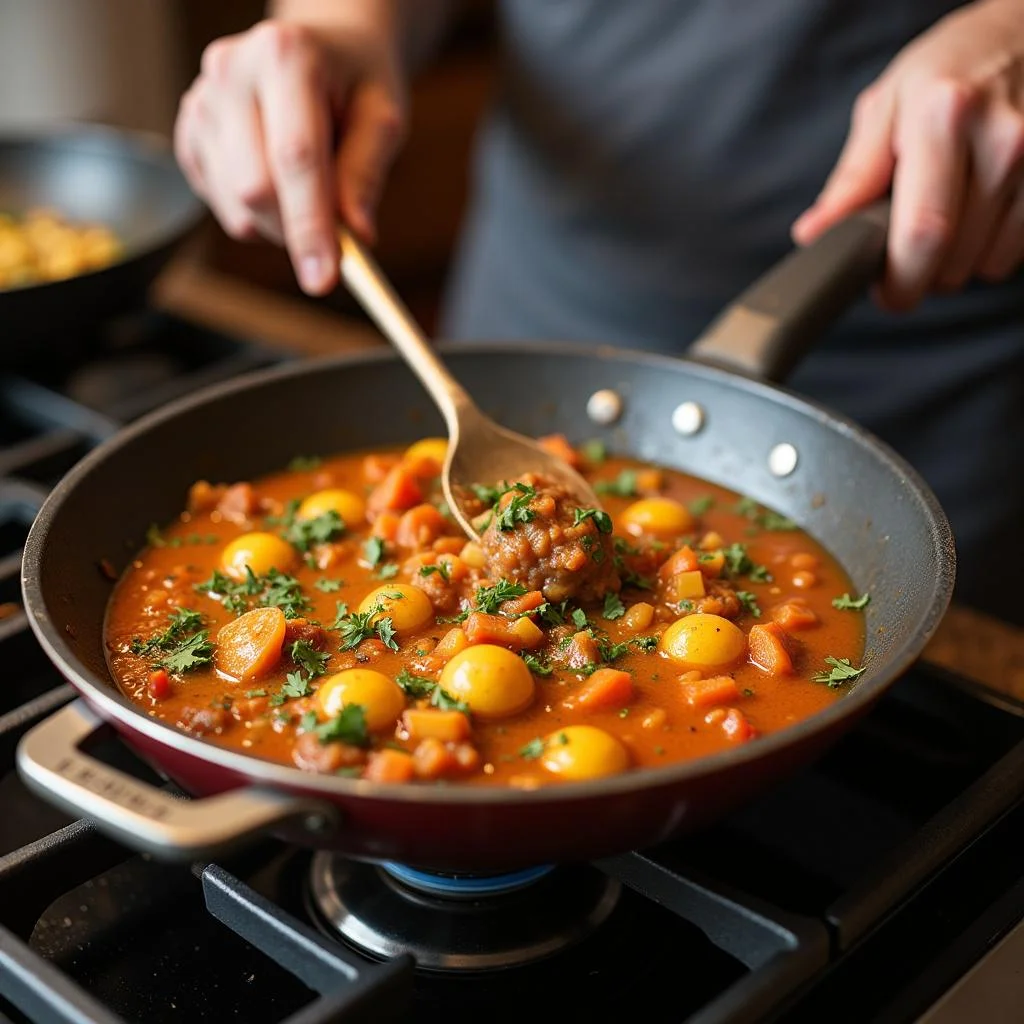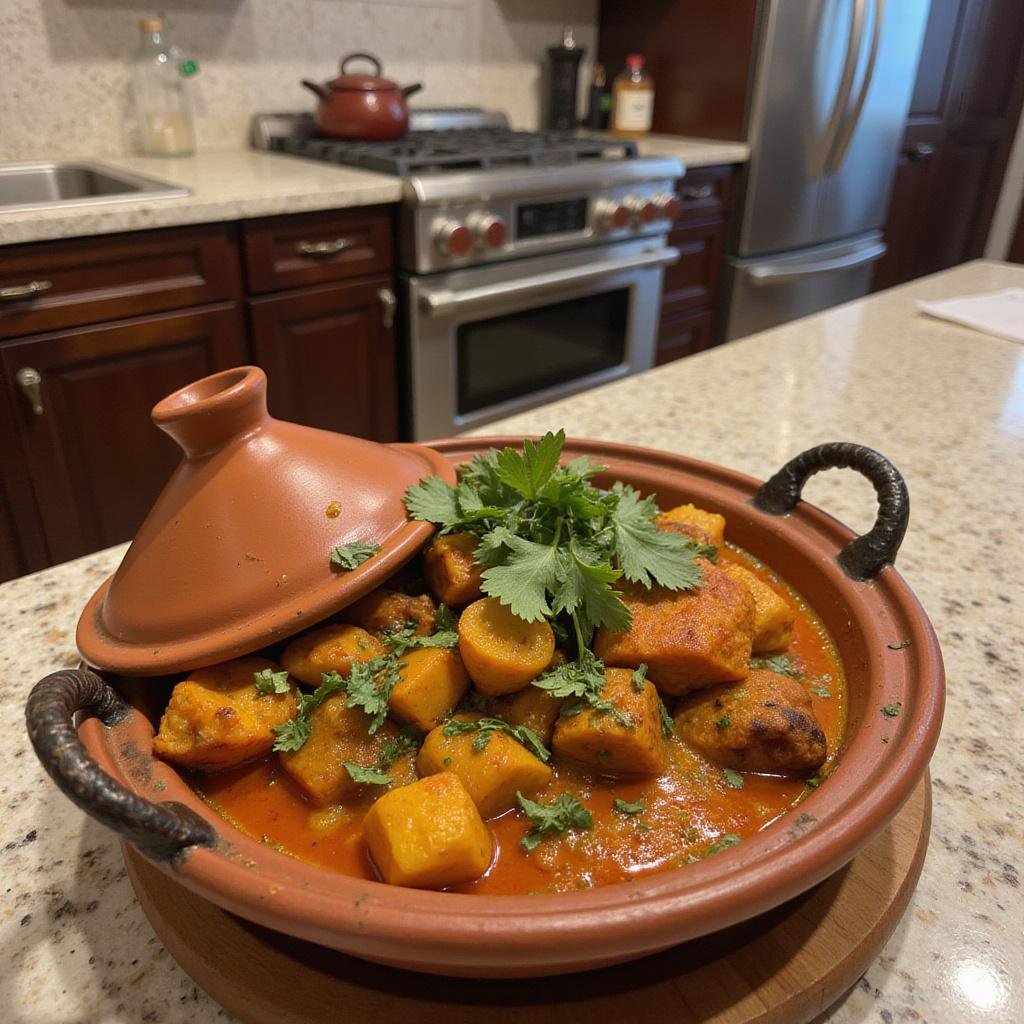1. Introduction
Moroccan tagines are celebrated worldwide for their rich, aromatic flavors, and tender, flavorful meat and vegetable dishes. The magic behind authentic Moroccan tagines lies in their traditional cooking method, utilizing a specially designed tagine pot that creates a unique environment for luscious, slow-cooked meals. However, not everyone has access to a traditional tagine, which can sometimes be considered an investment or specialty item. Fortunately, there’s good news: you can make delicious Moroccan tagines without a traditional tagine, simply by using common kitchen tools like cast iron Dutch ovens or even modern appliances such as slow cookers. Incorporating these alternatives not only makes Moroccan cuisine more accessible but also allows culinary enthusiasts to explore the best kw in creating flavorful, authentic dishes. Additionally, assembling the right ingredients and utensils—the essentials for flavorful Moroccan cooking—ensures your dishes turn out perfect every time. Whether you prefer starting with spices from [Indian spices](https://mealsmom.com/indian-spices-101-with-easy-curry-recipe/) or exploring global flavors via [ethnic dinner ideas](https://mealsmom.com/taste-the-world-7-easy-ethnic-dinners/), mastering the art of Moroccan tagines without a tagine is easier than ever.
2. Why Use a Tagine? Benefits of the Traditional Cooking Method
Before discussing how to make Moroccan tagines without a traditional tagine, it’s important to understand what makes the classic method so highly prized. The best kw in preparing Moroccan tagines is the unique cooking environment provided by the traditional tagine pot. Its conical lid traps steam, allowing moisture to circulate evenly back into the food, resulting in exceptionally tender meats and deeply infused flavors. The slow cooking process also enhances the aroma and depth of spice blends, creating an authentic Moroccan culinary experience—something that’s hard to replicate with standard cookware.
However, modern kitchen appliances such as the Ninja Air Fryer Pro 4-in-1 or versatile cookware like a [Cuisinart Bread Maker](https://amzn.to/3SUaa6c) and [KitchenAid Stand Mixer](https://amzn.to/4efLxec) help produce similar results by maintaining consistent heat and moisture. These tools are essential for achieving the same richness traditionally associated with Moroccan cuisine—without the need for a specialty tagine. Understanding and leveraging different techniques and special tools enables you to enjoy these sumptuous dishes regardless of your equipment, making the best kw accessible to everyone interested in exploring Moroccan culinary traditions.
3. Top Alternatives to a Traditional Tagine for Cooking Moroccan Dishes
Using a Dutch Oven
One of the most reliable substitutes for a traditional tagine is a Dutch oven. Its heavy-duty construction and tight-fitting lid trap moisture efficiently, creating a similar environment for slow braising Moroccan-style dishes. Incorporate aromatic spices like cumin, coriander, and saffron—ingredients you can find in a premium spice set—and cook on low heat for hours to develop depth of flavor. To enhance durability and ease of use, consider investing in high-quality cookware such as the [CAROTE Nonstick Pots and Pans](https://amzn.to/4kL0N5h), which ensures even heat distribution and long-lasting performance. Additionally, using a versatile [Crock-Pot 7 Quart Oval Slow Cooker](https://amzn.to/43MV74E) makes it straightforward to prepare Moroccan tagines with minimal effort, especially for busy households.

Using a Crockpot or Slow Cooker
The Crock-Pot is an excellent choice for cooking Moroccan tagines without a tagine, offering convenience and consistent results. The slow simmer allows flavors like preserved lemon, olives, and dried fruits to meld perfectly, mimicking the long, gentle cooking process of a traditional tagine. For this, a [Versatile Cookware for Large Families or Entertaining](https://amzn.to/43MV74E) such as a slow cooker is essential. Incorporate spices from a [comprehensive Indian spice set](https://mealsmom.com/indian-spices-101-with-easy-curry-recipe/) to add layers of complexity. Remember to include enough liquid, like broth or tomato sauce, and avoid opening the lid frequently, as this release of steam can hinder flavor development. This method is particularly suitable for tougher cuts of meat, such as lamb shoulder, which become exceptionally tender with slow cooking, just like in traditional Moroccan recipes.
Using a Heavy Bottomed Skillet or Saucepan
If you’re short on time or equipment, a heavy-bottomed skillet or saucepan can suffice for quick Moroccan tagines. Cover it with a tight lid and cook gently on low heat, allowing ingredients such as eggplant, zucchini, and chickpeas to soften and release their flavors. For optimal results, consider adding a [Ninja Blender](https://amzn.to/3FHdkaF) for blending tomato sauces or spice pastes to add depth and richness. This approach works well for smaller portions or when making an impromptu Moroccan-inspired meal. For extra flavor, incorporate ingredients like honey or preserved lemon, essential for authentic dishes. Combining these techniques with the right tools ensures you can create fragrant Moroccan-style meals anytime, even without a traditional tagine.
4. Tips for Making Moroccan Tagines Without a Tagine
- Use the right cookware: Opt for heavy, oven-safe cookware like a Dutch oven or cast iron skillet to mimic the slow, moist environment of a tagine, boosting flavor retention.
- Maintain low and slow cooking: Consistently cook on low heat or in the oven at low temperatures for hours to ensure tender, developing flavors — this is the secret of the best kw in Moroccan cooking.
- Add enough moisture: Use broth, tomato sauce, or preserved lemon juice to keep your dish moist, flavorful, and aromatic, crucial for authentic Moroccan taste.
- Utilize aromatic spices: Incorporate cumin, cinnamon, ginger, saffron, and coriander—spices fundamental to Moroccan cuisine—preferably from a [spice blend](https://mealsmom.com/indian-spices-101-with-easy-curry-recipe/) for richness.
- Cover tightly: Always ensure your cookware has a tight-fitting lid or use foil to trap steam, creating an environment similar to a traditional tagine for optimal flavor infusion.
These tips are key to mastering Moroccan tagines without the specialized cookware, ensuring your dishes are flavorful, authentic, and aromatic every time.
5. Delicious Moroccan Tagine Recipes You Can Make Without a Tagine
- Chicken with preserved lemon and olives: Simmer chicken pieces with lemon, olives, and aromatic spices in a Dutch oven or slow cooker for tender, flavorful results. Spice blends from [Indian or Middle Eastern sets](https://mealsmom.com/indian-spices-101-with-easy-curry-recipe/) elevate this dish.
- Lamb with apricots and almonds: Combine lamb, dried apricots, and toasted almonds, then cook slowly in a heavy pan or slow cooker. The sweet and savory contrast epitomizes Moroccan flavor profiles.
- Vegetable tagine: Roast root vegetables, zucchini, and chickpeas seasoned with cumin, cinnamon, and turmeric. These ingredients, along with aromatic spices from [essential kitchen tools](https://amzn.to/43MV74E), create a hearty, vibrant meal without a traditional tagine.
These recipes demonstrate how adaptable Moroccan cuisine truly is. You don’t have to own a specific pot to enjoy authentic flavors—just the right ingredients, spices, and a bit of patience in your favorite kitchenware. To add a modern twist, use tools like the [Fullstar Vegetable Chopper](https://amzn.to/4n5z40p) for prepping vegetables quickly or [air fryers](https://amzn.to/4jTwRSW) to roast vegetables or even cook small portions effortlessly. Embrace these alternatives and enjoy Moroccan dishes at home anytime.
6. Frequently Asked Questions (FAQs) about Moroccan Tagines Without a Tagine
Can I use an ordinary pot instead of a tagine?
Yes, absolutely. An ordinary pot with a tight-fitting lid, such as a Dutch oven or heavy saucepan, works perfectly for making Moroccan tagines without a traditional tagine. The key is to maintain low, consistent heat and ensure enough moisture to slow-cook your dishes into tender, flavorful meals. Tools like a [Cuisinart Bread Maker](https://amzn.to/3SUaa6c) can be useful for preparing accompanying bread or dough to serve alongside your Moroccan meal.
What is the best kw for cooking Moroccan tagines without a tagine?
The best kw involves using cookware that provides excellent heat retention and even cooking—like a Dutch oven, cast iron skillet, or slow cooker. These tools create a similar environment to a traditional tagine, helping to develop rich flavors and tender textures. You might also consider an oven for slow baking, or an all-in-one blender for preparing flavorful spice pastes, like the [Ninja Blender](https://amzn.to/3FHdkaF), which enhances your cooking process.
Can I make Moroccan tagines in an oven?
Definitely. Baking your Moroccan dishes in an oven at low temperatures for several hours is an excellent way to achieve slow-cooked tenderness and depth of flavor. Use oven-safe cookware with a tight lid — such as a Dutch oven — and preheat for best results. This method perfectly replicates traditional techniques and is especially useful when you want consistent, fuss-free results.
7. Conclusion
While the traditional Moroccan tagine offers a unique and celebrated cooking experience, you do not need a specialized tagine pot to enjoy authentic Moroccan flavors. By leveraging versatile kitchen equipment such as Dutch ovens, slow cookers, and heavy pans, you can craft delicious, aromatic Moroccan dishes that are just as satisfying. Emphasizing slow cooking, moisture retention, and the right blend of aromatic spices ensures your Moroccan-inspired meals will be flavorful, tender, and authentic—without the need for a traditional tagine. So, gather your spices, load up on essential cookware, and start exploring the vibrant world of Moroccan cuisine today—your taste buds will thank you!
To deepen your culinary journey, check out our guide on Indo-Asian spices and easy curry recipes or discover more delightful dishes with 7 easy ethnic dinners from around the world.

